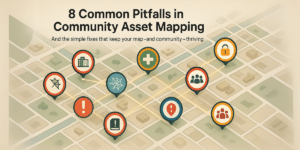The role of communication and marketing cannot be overstated in the realm of networks and coalitions. As entities aimed at achieving common objectives, their strength lies in the synergy of their members. However, this synergy can only be achieved through effective communication and strategic marketing efforts. While a lot of non-profit and public sector professionals cringe at the word ‘marketing’ it’s a core function of every network – sharing and positioning the value you’re creating with your community and key stakeholders. In this article, we’ll dig into 11 actionable coalition communication tips for networks of community partners.
Table of Contents
Understanding Communication for Networks & Coalitions
Before we dig into best practices, it is important to recognize how networks and other collaborative partnerships differ from a typical organization – and how those differences influence communication strategies, needs and priorities, internally and externally.
Firstly, networks and collaborative partnerships are inherently multi-dimensional. Comprising of various organizations or individuals, each with their own culture, working style, and communication preferences. This diversity demands a flexible and inclusive communication strategy that accommodates the needs of all constituents.
Secondly, decision-making within networks and collaborative partnerships is often consensus-based. As opposed to a hierarchical structure in typical organizations, decisions in a network or coalition tend to require agreement among various members. This necessitates a robust and transparent communication process, ensuring all members have access to relevant information and opportunities to voice their perspectives.
Thirdly, unlike single organizations, networks and collaborative partnerships often grapple with communicating a unified message that represents a range of diverse entities. This challenge calls for the creation of a strong and cohesive brand identity that aligns with the shared vision and objectives of the partnership.
Lastly, networks and partnerships usually operate in a more complex and dynamic environment with limited resources and staffing compared to an established non-profit organization. This requires a responsive, flexible and adaptable communication strategy that can swiftly respond to changes, capitalize on opportunities, and mitigate risks without breaking the bank.
With these differences in mind, here are 15 coalition communication tips to start using with your network or collaborative.
1. Get clarity on your shared goals
Everyone joins a coalition or network because they believe there is value in working together, but that does not necessarily mean there is shared agreement about the problem they want to address or the solution they plan to implement. Some people may join a network to advance a specific solution or approach, while others might join to learn more about an issue or to network with others working on similar problems. Before you start communicating, take time to understand where you and your partners agree on your goals and where there are disagreements. Identifying a final set of shared aspirations will help align and guide your work and make the most of your limited resources.
This process is best-done face-to-face, where communicating is easier and prone to less errors. If your goals are broad or there is significant disagreement or previous bad history, the process can be helped along with the use of a trained facilitator. They have a set of skills specifically for these situations to help move the conversation along and ensure we use a high-quality process that leads to a high-quality result. Some networks have facilitator members who play this role, while others bring in a consultant. Either way, it is worthwhile to do so.
2. Build a brand to share credit
One of the most common causes of conflicts in a network or coalition are issues involving turf and credit. Many organizations, especially non-profits, need to get credit for their work and impact to drive fundraising and engagement with volunteers. When one partner speaks on behalf of their partners, claims credit for shared work, or otherwise step on others’ turf, it can lead to resentment and a loss of trust that can eventually criple collaboration. In one network we worked with, a partner created significant conflict when they wrote and published a press release about the full network’s work and impact, without mentioning or thanking any of their partners. Eventually, several of the key stakeholders left the network as a result.
Most networks or coalitions will benefit from a single, shared brand that represents all members equally. The brand establishes a single name, logo, and style associated with the network that can be used to speak with one voice to the public. However, a brand is also helpful for networks that are focused internally, like communities of practice. A brand helps members differentiate between formal group communication and informal messages from partners or stakeholders. They also provide a better sense of buy-in from partners, especially early in the life of the network, by presenting it in a professional light akin to a formal organization. Best of all, creating a brand is free using tools like Canva.com and Hubspot.com

3. Establish clear communication channels
Regular communication among your partners keeps everyone updated on the work of the coalition, especially in the time between meetings. However, different organizations and people prefer different ways of communicating. Establishing multiple, clear channels to communicate helps ensure you meet the needs and expectations of a variety of partners. However, it is important to balance your options and pick the most relevant, rather than all of them – it is difficult to manage more than 3-4 channels without getting more people involved or hiring staff. Here are some common communication channels used by our partners:
- Email: You can use your existing email, set up a free account for the network on gmail, or use an email tool like MailChimp
- Social Media: The most popular are Facebook, LinkedIn, Twitter, and Instagram
- Miro: If your partners are visual thinkers, use Miro to create charts and mind maps, whiteboard ideas, and share them with others
- Google Forms: Communication is a two-way street. Use Google Forms to ask your network for feedback and gather information.
- Slack: You can create a free Slack Channel to allow your partners to message each other – ideal if they already use it
- Zoom: Their free plan is great for virtual meetings and one-to-ones with your network partners. Pay to host webinars too.
- Shared Drive: A Google Drive is free to set up and lets you host and share files and documents with your network
- Newsletters: Keep your partners updated with a regular (weekly, bi-monthly, or monthly) email or printed newsletter.
- Website: You can set up a WordPress website on SiteGround for less than $150 to post blogs, share content, promote events, and more.
4. Keep critical communication transparent
Not everyone in a coalition has the time, resources, or level of interest to participate in every decision-making moment. To ensure all partners feel involved and have a sense of ownership of the final result, make sure decisions and discussions are transparent and visible to those not present. If major decisions will be made, make an effort to let those with a stake in the issue know about it so they can attend if possible. Do not make it an exercise in futility where a decision is pre-ordained or this can hurt your relationships instead of strengthening them.
Once a major decision is made, take time to let the rest of the group know what it is. Explain the reason the decision was made, and what other alternatives existed. Preventing surprises about decisions as well as what else could have happened is an effective way to prevent misunderstandings and conflict down the road. For general members, an email usually suffices. For those with a stake on the specific decision, a phone call or video chat might be warranted depending on the relationship.

5. Build a strategy to support your coalition goals
Marketing and communication strategies and tactics are diverse and serve a variety of different needs and goals. When thinking about how your network can utilize marketing as a tool, you should think back to how it can support your shared goals. For example, if your network’s goal is to foster more information-sharing among its members, you should focus on internal communication tactics and strategies. You probably don’t need to do much PR work, for example. However, if your coalition is trying to influence the policymaking process or change a specific statute or bill, it is essential to speak outward and engage in more externally-focused forms of marketing and communication. Here are some various strategies and the goals they support:
Goal: Information-sharing among members
Strategies & Tactics: Social media groups, Blogging, Slack, Google Drive, Email Newsletters
Goal: Influence public policy
Strategies & Tactics: Social Media Pages, PR and Earned Media, Ads, Email Marketing, Blogging, Webinars, Event Marketing
Goal: Aligning members on goals/approaches
Strategies & Tactics: Zoom, Miro, Google Drive & Workspace, Social Media Groups, Google Forms
6. Leverage social media channels
Social media is a versatile tool that can serve many different purposes. Whether your network is internally-focused or outward-oriented, social media platforms can help you reach your goals. For internal communication, utilize groups on Facebook or LinkedIn (neither is inherently better – we recommend using whatever is most widely used among your partners – and sticking to only one group, so there isn’t a communication gap between them).
For external communication and marketing, you should setup a page or profile for your collaborative on popular social media sites like Facebook, LinkedIn, and Twitter. These are the three most popular platforms – additional options to consider are Instagram and TikTok. Here’s a quick summary of each and what they do best..
- Facebook: The most popular social site, a versatile option where you can create groups, post visual and written content, and run ads.
- LinkedIn: A social site for working professionals. Best for more professional/institutional networks and for serious, work-oritented content.
- Twitter: A microblogging site where users write 280-character long ‘tweets’. Fast-paced, focused on dissemination, without many collaboration features.
- Instagram: A visual platform that emphasizing sharing graphics and video without links. Good for building public awareness.
- Tik Tok: A video platform for sharing and watching short homemade videos on your smartphone. Great for public communications.
7. Work with media contacts to cultivate earned media
If your network is trying to chance public policy, attract funding and new members, or otherwise interact with the broader community, earned media is a great way to get in the spotlight without paying for it. This refers to news stories or coverage of your coalition by newspapers, journalists, bloggers, podcasts, and other news sources in your community. It is possible some of your members have relationships with media contacts you can leverage. If you don’t, you can still reach out to relevant journalists to pitch a story. Focus on how the coverage would benefit their readers and provide value to them – always the key to creating new partnerships.

8. Harness storytelling where possible
Whether you are pitching to a journalist or writing a social media post, your content is enhanced when presented as a story. Humans are natural storytellers and react more positively when they hear one than if presented with facts or numbers without context. Here are some tips to create a compelling story that drives action.
Create a Narrative Arc: A compelling story follows a clear beginning, middle, and end. This structure keeps your audience engaged and provides a cohesive narrative for your network or coalition’s journey.
Humanize and Evoke Emotion: Highlight the individuals making a difference within your network or coalition. Sharing their challenges, victories, and impacts helps humanize your story and evoke emotional engagement.
Use Descriptive Language: Use vivid and descriptive language to paint a clear and immersive picture of your story, enhancing the audience’s understanding and connection to your mission and efforts.
End with a Call to Action: Conclude your story by guiding your audience on what to do next. This could range from joining your network, contributing resources, or spreading your message.
9. Use data to adapt your communication
Most communication tools include a way to track your performance and interactions and access your data over time. For example, Google Analytics lets you track and analyze visits to your websites, and each social media site has data insights on your views, engagements, and followers over time. Many organizations have access to this information but never take the time to review it. Learning is a critical network function, and that includes in the communication and marketing realm.
This is daunting to many people, but it doesn’t have to be. Here are some simple ways to use data to inform your marketing and communication strategies and tactics:
- Test new messaging with social media posts or emails to compare engagement vs other messaging options.
- Review Google Analytics and email performance to identify the content, topics, and channels, that perform best over time. Use it to inform your future content creation work.
- Use surveys to gather your data from your partners or target audiences to identify interests, needs, preferred channels, etc.
- Conduct interviews or focus groups to explore qualitative aspects of your target audience interest, values, or behaviors.

10. Be clear on your target audiences
As you can tell from the point above, it is important to understand who you are talking to. Surveys, interviews, and focus groups are all great ways to get to know your audience and what drives them. However, first you need to decide who that audience is – and more importantly, who it is not. If you try to talk to everyone, you’ll water down your message so much that it feels cold and impersonal to everyone. It is better to segment your communications, with different content or channels or each important sub-group you need to communicate to. For example, if you are a network focused on education, you might utilize social media to communicate with students, while using emails to interact with their parents and teachers.
Your target audience depends on your specific goals. Internally-oriented networks focused on information-sharing and co-learning will often have their own members as their audience, along with external funders or other major stakeholders and sponsors. Externally-oriented coalitions, like those engaged in policy change, will have to deal with a much broader number of audiences, including external allies, the media, key decision-makers, those opposed to the changes, and the broader public at-large.
11. Utilize email updates and newsletters
Email marketing software is usually free if you have a limited number of email contacts. This makes them an ideal choice to send email updates to your network to keep everyone updated. I recommend sharing a regular newsletter no less often than once a quarter, or your network may not remember what it is. If possible, send an update once a month – this helps build brand recognition more quickly to keep new members engaged. Setting your partners’ expectations upfront about how often you’ll be emailing will help ensure they aren’t surprised by them down the road.
There are a lot of options for email updates:
- Regular newsletter: List of updates, news articles, resources, information or data relevant to your network or coalition.
- Automated emails: Create an automated series of emails to onboard new members, educate subscribers, or promote your work.
- Promotional emails: Create emails to promote policy change, share resources, or advertise an event.
- Follow-up emails: After every meeting, send a short email with the notes, action items, and other key info with everyone who attended.
12. Create content that provides value
We have mentioned content a lot – what is it? Content is a broad term that includes anything you write, design, or create to communicate or share an idea. Some examples include: websites, blog articles, social media posts, graphic designs, emails and newsletters, webinars, and more. Content serves many purposes, but a golden rule to follow across the board is to emphasize value-creation in everything you make. Whether you are writing an email, designing a website, or posting on Facebook, your content should provide value to your target audience in a way that also conveys the message you want to share.
For example, this is easy when communicating with partners because you share the same goals. By providing them meeting notes or an update on your network’s progress, you help them stay updated on an issue they care about – if they didn’t care, they probably would never have joined. However, this is more difficult when communicating with the public or other entities with conflicting goals and knowledge. By identifying and addressing a problem, area of interest, or value that is aligned with your messaging, you can capture their attention and engage them and still get your point across. This is a delicate balance that takes time to develop – but it’s critical to create effective content that reaches your goals.
13. Use your marketing to build external partnerships
Marketing is not just about selling something – it’s also about building relationships. Every sale starts with a new connection forming between buyer and seller. Marketing can help you build more partnerships externally using many of the same tactics used to generate relationships with leads and buyers. For example, reach out to influential institutions or stakeholders whom you want to establish a relationship with and invite them to present at a webinar, speak at an event, or write an article for your newsletter. This is an easy way to create a new connection and generate early trust without forcing someone to join the coalition upfront.
Coalition Communication Tips: The Last Word
Communicating with a network of partners is different from a typical organization in various ways. Budgets are smaller, plans are more flexible, viewpoints are diverse, and things generally are more messy. However, communication and marketing tactics and strategies can help a network function effectively by keeping your members connected and informed and helping you engage effectively with external partners, stakeholders, and the general public. These tips are just a sample of the tools and tactics available to coalitions and collaboratives. To learn more, attend my upcoming webinar on Marketing and Communication Tactics and Strategies on June 21st, 2023. We’ll dig into this in detail and allow you to ask questions too. See you then!






